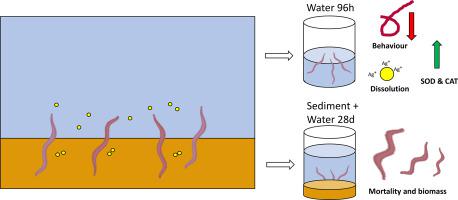NanoImpact ( IF 4.7 ) Pub Date : 2021-01-22 , DOI: 10.1016/j.impact.2020.100291 Simon Little 1 , Helinor J Johnston 2 , Vicki Stone 2 , Teresa F Fernandes 1

|
The use of silver (Ag) and titanium dioxide (TiO2) nanomaterials (NMs) in industrial processes and consumer products has experienced considerable growth since the late 20th century. Throughout their lifecycle, both Ag NM and TiO2NM are released into the environment, with benthic systems anticipated to be the final sink. Their potential toxicity towards benthic species is therefore of major concern. This study investigated the toxicity of silver (Ag; NM-300 K) and titanium dioxide (TiO2; NM-104) NMs to the freshwater oligochaete, Lumbriculus variegatus in acute (0–96-h) waterborne and chronic (28-d) sediment studies. Toxicity was investigated via assessment of mortality, behaviour, and antioxidant enzyme activity. The 96-h LC50 for Ag NMs in water was 0.51 mg/l (95% CI, 0.45–0.56), with L. variegatus displaying inhibited predation-avoidance behaviour compared to controls (6.66 ± 10%) successful response at 24-h), as well as significant increases (p < 0.05) in catalase (CAT) activity at sub-lethal concentrations at 24-h. Behavioural improvement and the return of antioxidant enzymes to control levels was observed after 48 and 72-h. AgNO3 exposure proved more toxic than Ag NM (96-h LC50 = 0.034 mg/l, 95% CI, 0.031–0.037) but resulted in no changes to antioxidant enzymes following sub-lethal exposure. Furthermore, Ag dissolution from Ag NM (~2–4%) could not account for the full extent of toxicity observed, suggesting a nano-specific effect. Increased environmental relevance via the inclusion of Suwannee River Humic Acid (SRHA, 5 mg/l) alleviated sub-lethal Ag NM toxicity despite a comparable 96-h LC50 (0.54 mg/l, 95% CI, 0.51–0.57). Significant effects of Ag NMs in formulated sediments (mortality, biomass) were only recorded according to OECD 225 at the highest test concentration (1333 mg/kg) for Ag NM indicating a potential attenuating effect of sediments towards toxicity. No toxicity was observed for TiO2 NM in aquatic or sediment exposures up to concentrations of 2000 mg/l and 1333 mg/kg, respectively.
中文翻译:

银和二氧化钛纳米材料对寡毛类动物 Lumbriculus variegatus 的急性水性和慢性沉积物毒性
自 20 世纪末以来,银 (Ag) 和二氧化钛 (TiO 2 ) 纳米材料 (NM) 在工业过程和消费品中的使用经历了可观的增长。在其整个生命周期中,Ag NM 和 TiO 2 NM 都会释放到环境中,预计底栖系统将成为最终的汇。因此,它们对底栖物种的潜在毒性是主要关注的问题。本研究调查了银 (Ag; NM-300 K) 和二氧化钛 (TiO 2 ; NM-104) NMs在急性 (0-96-h) 水性和慢性 (28- d ) 沉积物研究。通过评估死亡率、行为和抗氧化酶活性来研究毒性。96 小时液相色谱水中 Ag NMs 的50为 0.51 mg/l(95% CI,0.45-0.56),与对照相比,L. variegatus表现出抑制的捕食回避行为(6.66 ± 10%)在 24 小时内的成功响应),以及 在 24 小时亚致死浓度下,过氧化氢酶 (CAT) 活性显着增加 ( p < 0.05)。在 48 和 72 小时后观察到行为改善和抗氧化酶恢复到控制水平。AgNO 3暴露证明比 Ag NM 毒性更大(96 小时 LC 50 = 0.034 mg/l, 95% CI, 0.031–0.037),但在亚致死暴露后抗氧化酶没有变化。此外,Ag NM (~2-4%) 中的 Ag 溶解不能解释观察到的全部毒性程度,表明具有纳米特异性效应。尽管 96 小时 LC 50 (0.54 mg/l, 95% CI, 0.51–0.57)相当,但通过添加 Suwannee River Humic Acid (SRHA, 5 mg/l) 增加了环境相关性,减轻了亚致死的 Ag NM 毒性。仅根据 OECD 225 在 Ag NM 的最高测试浓度(1333 mg/kg)下记录了 Ag NM 在配制沉积物中的显着影响(死亡率、生物量),表明沉积物对毒性的潜在减弱作用。TiO 2未观察到毒性水生或沉积物中的 NM 浓度分别高达 2000 mg/l 和 1333 mg/kg。







































 京公网安备 11010802027423号
京公网安备 11010802027423号